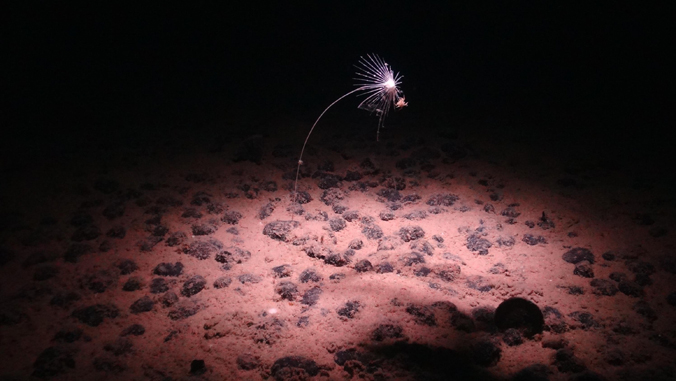
A biogeographical boundary—a transition zone that divides soft-bodied and shelled creatures—was discovered at the bottom of the North Pacific Ocean, according to a study co-authored by Craig Smith, oceanographer at the University of Hawaiʻi at Mānoa.
This limit separates two distinct biological areas across the Clarion-Clipperton Zone, a vast abyssal plain region extending more than 3,000 miles between Mexico and Kiribati, at depths between 11,000 to 20,000 feet (3,500 to 6,000 meters), and which is currently targeted for deep-sea mining.
The study also revealed that there is a surprising increase in diversity with depth in this region, challenging the long-held paradigm in deep-sea ecology that biodiversity is limited by the harsher living conditions in deeper areas of the ocean.
"These results are really important because they show the abyssal seafloor communities in areas targeted for deep-sea mining are highly biodiverse and more heterogeneous than expected," said Smith, a professor emeritus in the Department of Oceanography at the UH Mānoa School of Ocean and Earth Science and Technology. "The dramatic shift in abyssal seafloor communities over a depth change of only 500 meters [~1,600 feet] means that mining large seafloor areas for polymetallic nodules may lead to higher risks of species extinctions than was previously appreciated."
The study showcases the patterns and processes that underpin deep ocean's biodiversity, and how these differ between shallower and deeper regions in a vast abyssal nodule field habitat that is currently targeted for mining. This provides a new basis for regional-scale management strategies to protect biodiversity in Earth's largest biome.
Erik Simon-Lledó, deep-sea ecologist at the National Oceanography Centre (NOC) and lead author on the paper, said, "We were surprised to find a deep province so clearly dominated by soft anemones and sea cucumbers and a shallow-abyssal where suddenly soft corals and brittle stars were everywhere."
"We have known for some time that the abyssal plains are relatively high in biodiversity," said Adrian Glover, principal scientist at the National History Museum and co-author of the study. "What has been missing is knowledge of how that diversity is distributed and how it changes across broad spatial scales. These new data revolutionize our understanding of abyssal Pacific biogeography and will be vital to inform urgent policy decisions on potential deep-sea mining."
The study suggests water chemistry, specifically the saturation of calcium carbonate, the mineral that forms the shells and skeletons of many animals, might be an overlooked factor in delineating this boundary and therefore key in shaping biodiversity across this vast area.
"Muddy abyssal seafloors were initially considered to be almost 'marine deserts' when first explored many decades ago, given the extreme conditions for life there—with a lack of food, high pressure and extremely low temperature," Simon-Lledó added. "But as deep exploration and technology progressed, these ecosystems keep unveiling a large biodiversity, comparable to that in shallow water ecosystems, only found on a much wider spatial spread."
Daniel Jones, principal scientist at NOC and senior co-author of the study, said, "The research findings are the result of a 10-year-long study in collaboration with more than 13 world-leading deep-sea research institutions, universities, and industry bodies, and involved 21 deep sea researchers. It shows the value of international collaboration in uncovering unknown patterns across huge areas of the ocean."






